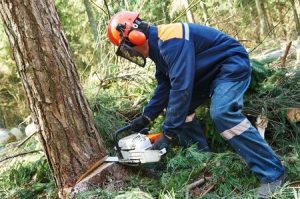
After years of hoping it might rally and sprout new growth in the spring, you’ve finally accepted that the oak tree in the back yard has reached the point of no return. It is decidedly quite dead. You spend a few days circling it, looking up into the canopy and thinking, “Yeah, I could do this. No problem.” Sure, it’s been a few years since you had to break out the old chainsaw, but it’s like riding a bike, right? A gas powered bike with razor sharp blades spinning at 60 mph, but a bike nonetheless. Hmm, maybe it’s time to re-think this analogy.
Proficiency with a chainsaw is a valuable skill to have, but it can come at a steep cost. There’s just no getting around the fact that chainsaws are downright dangerous. As chainsaw operators, it’s our responsibility to do everything in our power to protect ourselves from injuries when working with these powerful tools. With this in mind, we thought we’d take a moment to share a few essential chainsaw safety tips with our readers.
Be Aware of Your Surroundings
You and the tree you’re about to fell do not exist in vacuum. There are likely all sorts of environmental factors that stand to sabotage your endeavor. Before you start sawing, take a moment to take stock of your surroundings. Identify a clear path of escape for when the tree begins to fall. Keep an eye out for things like power lines that might become collateral damage. Find a spot to stand that provides you with even, sure footing. If, at any point, you have creeping doubts about the safety of the situation, stop and consult a professional.
Prepare for Pinch and Kickback
Pinching occurs when the weight of the tree clamps down on the bar and abruptly stops the spinning of the chain. Do your best to cut at an angle that causes the tree to lean back, away from the blade. Pay close attention to the kerf – the channel in the wood formed by the chainsaw. If it begins to close, stop and try to find a better angle to cut from.
Kickback occurs when the tip of the bar hits an especially solid object such as a knot in the wood and causes the chainsaw to violently jump – often in the direction of the operator. To avoid kickback, apply steady, even pressure to the bar and always begin cuts with the lower edge of the bar rather than the tip.
Practice Good Form
Sometimes the most basic safety precautions are also the most effective. Take a wide stance before you cut, and always check your footing before you begin. Keep an eye out for trip hazards such as fallen limbs and loose stones. Keep both hands on the chainsaw – one on the throttle guard and one on the front handle – at all times. Kickback can, and will happen when you least expect it. The last thing you want to do is drop your guard. Vigilance is Key.
If you have the know-how but lack the equipment, Lawrence Tool Rental is here to help. Call today for more information!
[msh_feedburner]

Leave a Reply